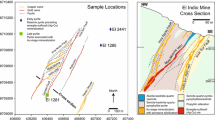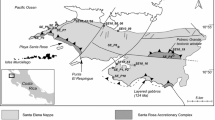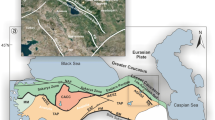Abstract
The stratiform Cu-Zn sulfide deposit at Kupferberg in Germany represents Bavaria’s largest historic base metal producer. The deposit is hosted by Early Paleozoic volcano-sedimentary strata at the margin of a high-grade allochthonous metamorphic complex. The present paper reports on the first Cu and S isotope data as well as trace element analyses of pyrite from this unusual deposit. The new data point to syn-orogenic mineralization that was driven by metamorphic fluids during nappe emplacement. Primary Cu ore occurs as texturally late chalcopyrite within stratiform laminated pyrite in black shale in two different tectonostratigraphic units of very low and low metamorphic grade, respectively, that were juxtaposed during the Variscan orogeny. Trace element contents of different pyrite types suggest the presence of at least one hydrothermal pyrite generation (mean Co/Ni = 35), with the other pyrite types being syn-sedimentary/early diagenetic (mean Co/Ni = 3.7). Copper isotope analyses yielded a narrow δ65Cu range of −0.26 to 0.36‰ for all ore types suggesting a hypogene origin for the principal chalcopyrite mineralization. The ore lenses in the two different tectonostratigraphic units differ with regard to their δ34S values, but little difference exists between poorly and strongly mineralized domains within a given locality. A genetic model is proposed in which syn-sedimentary/early diagenetic pyrite with subordinate chalcopyrite and sphalerite formed in black shale beds in the two different stratigraphic units, followed by late-tectonic strata-internal, hydrothermal mobilization of Fe, Cu, and Zn during syn-orogenic thrusting, which concentrated especially Cu to ore grade. In agreement with this model, Cu distribution in stream sediments in this region shows distinct enrichments bound to the margin of the allochthonous complex. Thus, Kupferberg can be considered a rare example of a syn-orogenic Cu deposit with the Cu probably being derived from syn-sedimentary/early diagenetic pyrite contained in Early Paleozoic shale units.








Similar content being viewed by others
References
Baatartsogt B, Schwinn G, Wagner T, Taubald H, Beitter T, Markl G (2007) Contrasting paleofluid systems in the continental basement: a fluid inclusion and stable isotope study of hydrothermal vein mineralization, Schwarzwald district, Germany. Geofluids 7:123–147
Bajwah ZU, Seccombe PK, Offler R (1987) Trace element distribution, Co:Ni rations and genesis of the Big Cadia iron-copper deposit, New South Wales, Australia. Mineral Deposita 22:292–300
Barnes RG (1987) Multi-stage mobilization and remobilization of mineralization in the Broken Hill Block, Australia. Ore Geol Rev 2:247–267
Brand H (1922) Die Kupfererzlagerstätte bei Kupferberg i. Oberfranken mit besonderer Berücksichtigung ihrer Beziehung zur Münchberger Gneismasse. Geogr Jahrb 34:1–102
Cox SF (2005) Coupling between deformation, fluid pressures, and fluid flow in ore-producing hydrothermal systems at depth in the crust. In: Hedenquist JW, Thompson JFH, Goldfarb RJ, Richards JP (eds) Economic Geology 100th Anniversary Volume, Littleton, pp 39–75
Dill H (1985) Die Vererzung am Westrand der Böhmischen Masse – Metallogenese in einer ensialischen Orogenzone. Geol Jahrb 73:3–461
Dill H, Kemper E (1990) Crystallographic and chemical variations during pyritization in the upper Barremian and low Aptian dark claystones from the Lower Saxonian Basin (NW Germany). Sedimentology 37:427–443
Elderfield H, Schultz A (1996) Mid-ocean ridge hydrothermal fluxes and the chemical composition of the ocean. Annu Rev Earth Planet Sci 24:191–224
Emmert U, Horstig GV, Weinelt W (1960a) Erläuterungen zur Geologischen Karte von Bayern 1:25 000 Blatt Nr. 5835 Stadtsteinach. Bayerisches Geologisches Landesamt, München
Emmert U, Horstig GV, Weinelt W (1960b) Geologische Karte von Bayern 1:25 000 Blatt Nr. 5835 Stadtsteinach. Bayerisches Geologisches Landesamt, München
Fauth H, Hindel R, Siewers U, Zinner J (1985) Geochemischer Atlas der Bundesrepublik Deutschland. Verteilung von Schwermetallen in Wässern und Bachsedimenten. Bundesanstalt für Geowissenschaften und Rohstoffe, Hannover
Franke W, Kreuzer H, Okrusch M, Schüssler U, Seidel E (1995) Exotic metamorphic nappes—stratigraphy, structure and igneous activity. In: Dallmeyer RD, Franke W, Weber K (eds) Pre-Permian geology of central and eastern Europe. Springer, Berlin, pp 277–294
Gregory DD, Large RR, Halpin JA, Baturina EL, Lyons TW, Wu S, Danyushevsky L, Sack PJ, Chappaz A, Maslennikov VV, Bull SW (2015) Trace element content of sedimentary pyrite in black shales. Econ Geol 110:1389–1410
Grinenko VA (1962) The preparation of sulphur dioxide for isotopic analysis. Zh Neorgan Khim 7:2478–2483
Guy BM, Beukes NJ, Gutzmer J (2010) Paleoenvironmental controls on the texture and chemical composition of pyrite from non-conglomeratic sedimentary rocks of the Mesoarchean Witwatersrand Supergroup, South Africa. S Afr J Geol 113:195–228
Höhn S, Frimmel HE, Koglin N (2015) Multi-stage sulfidation at Bavaria‘s largest Cu-Zn deposit (Kupferberg/Germany). In: André-Mayer A-S (ed) Mineral resources in a sustainable world, Proceedings of the 13th Biennial SGA meeting, 24–27 August 2015, Université de Lorraine, Nancy, pp 1917–1921
Ibach R (1940) Zur Entstehung der Kieslagerstätte von Kupferberg in Oberfranken. Z Angew Geol 2:114–152
Ikehata K, Notsu K, Hirata T (2011) Copper isotope characteristics of copper-rich minerals from Besshi-type volcanogenic massive sulfide deposits, Japan, determined using a femtosecond LA-MC-ICP-MS. Econ Geol 106:307–316
Kajiwara Y, Krouse HR (1971) Sulfur isotope partitioning in metallic sulfide systems. Can J Earth Sci 8:1397–1408
Kampschulte A, Strauss H (2004) The sulfur isotopic evolution of Phanerozoic seawater based on the analysis of structurally substituted sulfate in carbonates. Chem Geol 204:255–286
Kimball BE, Mathur R, Dohnalkova AC, Wall AJ, Runkel RL, Brantley SL (2009) Copper isotope fractionation in acid mine drainage. Geochim Cosmochim Acta 73:1247–1263
Koglin N, Franz G, Glodny J, Schüssler U, Zeh A, Gerdes A, Brätz H (2014) Münchberg metamorphic complex: nature and ages of the nappe complex. In: Wagner J, Elger K (ed) GeoBerlin2015 - Dynamic earth from Alfred Wegener to today and beyond—abstracts. Annual Meeting of DGGV and DMG, 4–7 October 2015, GFZ German Research Centre for Geosciences, Berlin, pp 217–218
Large RR, Maslennikov VV, Robert F, Danyushevsky LV, Chang Z (2007) Multistage sedimentary and metamorphic origin of pyrite and gold in the giant Sukhoi Log deposit, Lena Gold Province, Russia. Econ Geol 102:1233–1267
Li W, Jackson SE, Pearson NJ, Graham S (2010) Copper isotopic zonation in the Northparkes porphyry Cu-Au deposit, SE Australia. Geochim Cosmochim Acta 74:4078–4096
Lu J, Seccombe PK, Eldridge CS (1996) SHRIMP S-isotope evidence for fluid mixing during gold mineralization in a slate-belt gold deposit (Hill End, New South Wales, Australia). Chem Geol 127:229–240
Markl G, Lahaye Y, Schwinn G (2006) Copper isotopes as monitors of redox processes in hydrothermal mineralization. Geochim Cosmochim Acta 70:4215–4228
Marshall B, Gilligan LB (1989) Durchbewegung structure, piercement cusps, and piercement veins in massive sulfide deposits; formation and interpretation. Econ Geol 84:2311–2319
Marshall B, Vokes FM, Larocque ACL (2000) Regional metamorphic remobilization: upgrading and formation of ore deposits. Rev Econ Geol 11:19–35
Mathur R, Fantle MS (2015) Copper isotopic perspectives on supergene processes: implications for the global Cu cycle. Elements 11:323–329
Mathur R, Munk L, Nguyen M, Gregory M, Annell H, Lang J (2013) Modern and paleofluid pathways revealed by Cu isotope compositions in surface waters and ores of the pebble porphyry Cu-Au-Mo deposit, Alaska. Econ Geol 108:529–541
Molnár F, Mänttäri I, O’Brien H, Lahaye Y, Pakkanen L, Johanson B, Käpyaho A, Sorjonen-Ward P, Whitehouse M, Sakellaris G (2016) Boron, sulphur, copper isotope systematics in the orogenic gold deposits of the Archaean Hattu schist belt, eastern Finland. Ore Geol Rev 77:133–162
Okrusch M, Seidel E, Schüssler U, Richter P (1989) Geochemical characteristics of metabasites in different tectonic units of the northeast Bavarian crystalline basement. In: Emmermann R, Wohlenberg J (ed) The German continental deep drilling program (KTB), Springer, Berlin, pp 67–79
Petit JCJ, De Jong J, Chou L, Mattielli N (2008) Development of Cu and Zn isotope MC-ICP-MS measurements: application to suspended particulate matter and sediments from the Scheldt Estuary. Geostand Geoanal Res 32:149–166
Reed MH, Palandri J (2006) Sulfide mineral precipitation from hydrothermal fluids. Rev Mineral Geochem 61:609–631
Ritter O, Haak V, Rath V, Stein E, Stiller M (1999) Very high electrical conductivity beneath the Münchberg gneiss area in southern Germany: implications for horizontal transport along shear planes. Geophys J Int 139:161–170
Rouxel O, Fouquet Y, Ludden JN (2004) Copper isotope systematics of the Lucky Strike, Rainbow and Logatchev sea-floor hydrothermal fields on the mid-Atlantic ridge. Econ Geol 99:585–600
Schüssler U (1993) Zur geologischen Situation der Erzlagerstätte Kupferberg-Neufang in der Umrahmung der Münchberger Gneismasse. Z Geol Wiss 21:231–236
Shelton KL, Burstein IB, Hagni RD, Vierrether CB, Grant SK, Hennigh QT, Bradley MF, Brandom RT (1995) Sulfur isotope evidence for penetration of MVT fluids into igneous basement rocks, southeast Missouri, USA. Mineral Deposita 30:339–350
Sparks HA, Mavrogenes JA (2005) Sulfide melt inclusions as evidence for the existence of a sulfide partial melt at Broken Hill, Australia. Econ Geol 100:773–779
Urban H, Vaché R (1972) Die Kupfererzlagerstätte von Kupferberg-Wirsberg (Oberfranken) im Lichte neuer Aufschlüsse. Geol Bavarica 65:74–106
van Achterbergh E, Ryan CG, Griffin WL (2000) Glitter: on-line interactive data reduction for the laser ablation ICP-MS microprobe. Ninth Annual V. M. Goldschmidt Conference, 22–27 August 1999, Cambridge, Massachusetts, abstract no. 7215
Wedepohl KH (1995) The composition of the continental crust. Geochim Cosmochim Acta 59:1217–1232
Zheng YF (1990) Sulfur isotopes in metamorphic rocks. Neu Jb Mineral Abh 161:303–325
Zhu XK, O’Nions RK, Guo Y, Belshaw NS, Rickard D (2000) Determination of natural Cu-isotope variation by plasma-source mass spectrometry: implications for use as geochemical tracers. Chem Geol 163:139–149
Acknowledgements
We thank U. Schüßler for sharing his lifelong experience with the geology of the Kupferberg area, as well as H. Kliesch and R. Holhut from the Bergbau-Museum e.V. Kupferberg and M. Mäuser from the Naturkunde-Museum Bamberg for providing samples. H. Brätz assisted with the ICP-MS analyses. VD and WD thank Jeroen De Jong and Nadine Mattielli for managing the Nu-Plasma laboratory. Constructive criticism from two anonymous reviewers and the editors T. Monecke and B. Lehmann greatly improved the original version of the manuscript. Financial support was provided by the Hanns-Seidel-Stiftung e.V., the Oberfrankenstiftung (P-No. 04236), and the Hartsteinwerke Schicker OHG. VD thanks the FRS-FNRS and ERC StG “ISoSyc” for current funding.
Author information
Authors and Affiliations
Corresponding author
Additional information
Editorial handling: T. Monecke
Rights and permissions
About this article
Cite this article
Höhn, S., Frimmel, H., Debaille, V. et al. The case for metamorphic base metal mineralization: pyrite chemical, Cu and S isotope data from the Cu-Zn deposit at Kupferberg in Bavaria, Germany. Miner Deposita 52, 1145–1156 (2017). https://doi.org/10.1007/s00126-017-0714-z
Received:
Accepted:
Published:
Issue Date:
DOI: https://doi.org/10.1007/s00126-017-0714-z




